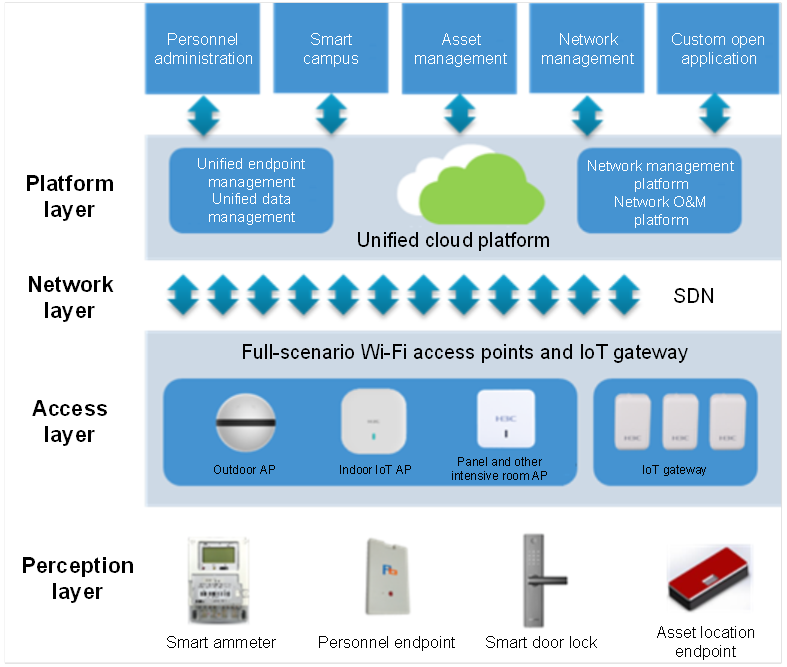H3C Campus Wireless IoT Solution
1. Demands
The network system is a key part of the campus information construction project and an important element for the successful delivery of the campus. With full understanding of the construction requirements, network construction is implemented with high quality and efficiency, keeping in mind the strategic objectives and operation and management concepts of the new campus. As smart mobile devices are becoming more and more popular, Wi-Fi network access has become a basic requirement for office and production service terminals. For the campus, a robust Wi-Fi network is essential to the campus as an important service infrastructure.
The campus wireless network mainly serves enterprises and visitors who pay more attention on user experience and performance of the wireless network. While providing Internet service for enterprises, the wireless network also achieves value-added operation for the campus: advertising push, wireless positioning, big data analysis, etc. It increases the experience and improves management efficiency by assisting enterprises and campus managers in behavior analysis. The wireless network is deployed in the indoor and outdoor public areas, office areas and operation areas of the campus. As an important part of the comprehensive service network, the wireless network mainly provides services for the production operation and daily office of the campus. It provides a wireless network communication platform for mobile POS of the business system, office staff's terminals, and hand-held scanning terminals of the production workshop, etc. The production efficiency of the whole campus is improved through the information-based network.
![]() Wireless coverage and bandwidth requirements
Wireless coverage and bandwidth requirements
Currently, with the rapid development of mobile Internet, an average of 1-3 wireless devices (mainly laptops, tablets, mobile phones and smart wearables) are used by each person at the same time. Users enjoy the convenience of mobile payment, mobile social networking, and mobile marketing. The campus Wi-Fi network must be accessible anytime, anywhere.
With the development of services, the wireless network not only needs to ensure the signal strength, but also consider applications such as remote HD conference, wireless data collection of a large number of office devices, which requires a wireless network at a higher speed. Meanwhile, with the popularity of smart phones, visitors can get better services such as navigation and marketing push through apps, requiring comprehensive wireless Internet access services in the campus.
![]() 2.2 Reliability of the wireless network
2.2 Reliability of the wireless network
First of all, wireless APs must be quality to adapt to all scenarios. Secondly, the wireless bearer network must be in redundant setting with robustness. The wireless ACs implement service management of the wireless APs in the whole network and need to use virtualization and other technologies to ensure that the failure of the ACs in the wireless network will not cause failure of the whole network and thus affect normal services. Therefore, redundancy and reliability design must be considered in this project.
![]() 2.3 Internet access verification of the wireless network
2.3 Internet access verification of the wireless network
The wireless network access layer is the first link of informatization security. With the full coverage of the wireless network, a comprehensive user and terminal access mechanism is a key element for guaranteeing the security of information assets. Only the verified terminal users can access the wireless network for effective management. On the one hand, it ensures the security of wireless access. On the other hand, it guarantees better services for users. To authorize the access to wireless user and devices and to encrypt the communication data are key demands of wireless network construction.
![]() 2.4 Management and O&M
2.4 Management and O&M
Different from the wired network, the characteristics of scattered terminals of the wireless network increase the complexity of wireless network construction and the problem of wide distribution of wireless devices, which makes O&M management troublesome.
Then, a visual wireless O&M management system is required to solve the O&M management problems, such as wireless network security, access management and certification. The wireless network O&M management shall also fully consider the characteristics of wireless network - mobile, to achieve intelligent and mobile management.
![]() 2.5 IoT expansion capability
2.5 IoT expansion capability
With the advent of the Internet+ era, the demand for mobile services is also increasing. Services such as instrument and device asset positioning and refined campus management have been widely applied in large corporate campuses, greatly improving management efficiency. However, these mobile services involve both the Internet and IoT, which were deployed separately in the past. Thus, multiple networks, multiple power supply systems, and multiple management platforms were created, resulting in fragmented data and management and high management cost.
2. H3C campus wireless IoT solution design

As a service bearer network that connects the users, terminals and service systems, the entire network is abstractedly classified into the following four levels by considering the logical structure of the wireless IoT.
Perception interaction layer: The smart terminals identify and classify personnel, devices and instruments through RFID, LoRa and other technologies. They acquire parameters through various sensors and devices, and realize local transmission, convergence, fusion and collaborative processing of perception data through routers, repeaters, base stations, gateways, etc.
Access transmission layer: It is the data link between the collection control layer and the application layer. It establishes a data transmission network through various transmission means such as wired links, wireless links and public network to complete tasks such as address parsing, routing service, network maintenance, and transaction scheduling. Therefore, it realizes the uploading of perception data and the issuance of linkage commands in a safe and reliable manner.
Platform layer: The data reported by the terminal layer is parsed to form a standard data format for unified storage. The platform layer blocks different access modes and data formats reported by the terminal layer, and it has the ability to manage terminals and support the access capability of mass terminals and gateways. It also provides unified open interfaces to upper-layer applications.
Application service layer: As the main component of the use-oriented system, the application layer gathers, analyzes, reconstructs and processes the data of each scenario in the campus, and makes comprehensive use of the data in combination with the objectives, tasks and nature of the specific campus applications. It realizes the mutual perception of nodes of the IoT and devices in the campus. It fully establishes the perception linkage between people and things, and between things. It also uses the IoT technology to build, reorganize and optimize the specific services.
3. Advantages
One network and one platform is the overall strategy of H3C wireless IoT. Through deep integration of the network and the platform, modular delivery of services and more flexible deployment, the overall construction and operation costs are reduced. Specific advantages of the solution are:
1. Strong IoT expansion capability
H3C's IoT expansion capability is outstanding in the industry. Traditional vendors either use feeder lines or USB, while H3C developed a cascade expansion model for IoT after sufficient market survey, which allows users to expand IoT services at any time through the deployment of one network. A single chain supports the expansion of more than 6 IoT modules, which is more flexible.
2. Integrated service management and O&M
H3C launched an original wireless IoT all-in-one machine for actual services, reducing the user investment and management complexity. With this device, the wireless IoT device management, scenario-based intelligent O&M, and third-party IoT business convergence are realized, ensuring customer service expansion on demand and modular deployment.
3. Open cooperation
Since the layout of wireless IoT, H3C has been attaching importance to the introduction of partners to provide customers with an optimal overall solution. We have been maintaining an open cooperation and keeping communications with many partners to guarantee quality of products from partners and integrate some products deeply with H3C product solutions. H3C provides users with products in a package to improve user's experience of overall management and service convergence.


